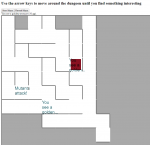TheCosmicKid
Hero
Once in a blue moon. They are a classic challenge, after all, and it wouldn't do to dispense with them entirely. The last maze I ran was full of mirrors which, naturally, flipped the party into a mirrored version of the maze whenever they passed one. That didn't take them long to figure out. But the twist within the twist was that the north-south oriented mirrors took them to a north-south mirrored maze, and the east-west oriented mirrors took them to an east-west mirrored maze, and then of course in each of those mazes you could flip the other direction to a maze mirrored both ways. So instead of dealing with two mirrored mazes as they thought, they were dealing with four mazes in two identical pairs.Do many folks still run their players through literal mazes? I always imagined they became passe in much the same fashion as they did in computer games and interactive fiction ("twisty little passages" indeed).
Because I was fully aware that this could get annoying fast, the maze wasn't actually that big. It was more a matter of learning the trick than navigating the maze.



